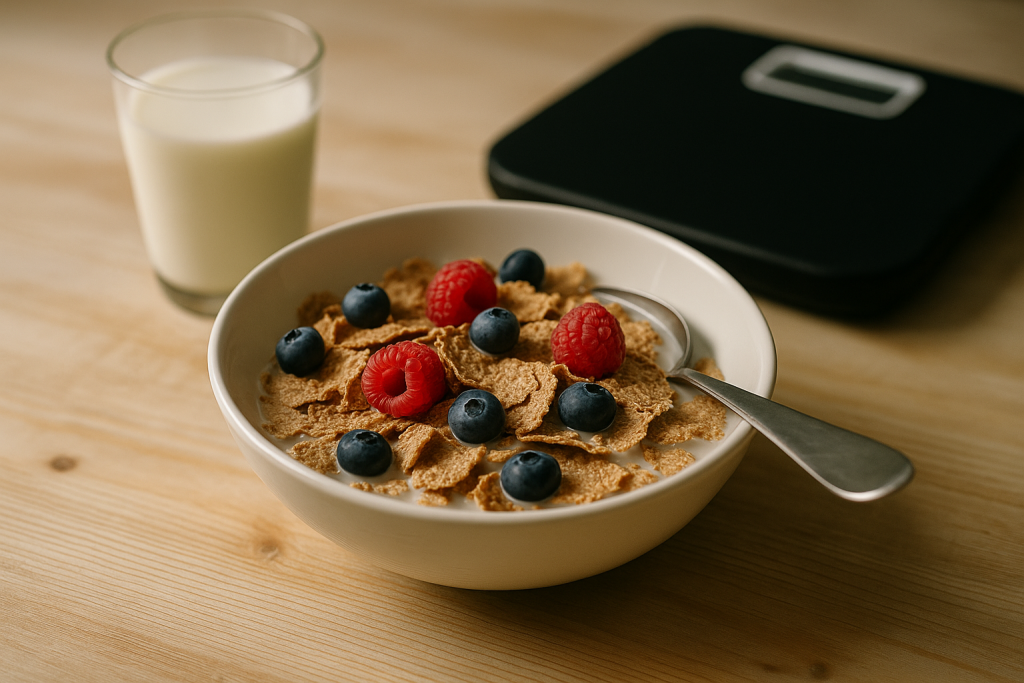Are Bran Flakes Good for Weight Loss?
The Short Answer
Bran flakes can help – if you pick the right box, watch portions, and build a balanced bowl. Fibre supports fullness. Lower sugar keeps calories in check. But a cereal is a tool, not a miracle. Honestly, most wins come from the boring bits done well.
What Bran Flakes Actually Are
Bran flakes are wheat-based breakfast cereal. The “bran” is the grain’s outer layer, rich in fibre and some micronutrients. Many brands also fortify with B-vitamins and iron. Fibre matters for health and can support weight control by helping you feel satisfied on fewer calories. UK guidance says adults should aim for 30g fibre a day – most of us only reach about 20g. A higher-fibre breakfast can close that gap.
Typical branded bran flakes provide around 3.7–5g fibre per 30–40g serving (check your label). That helps, but you still need fibre from the rest of the day – veg, pulses, wholegrains, nuts and seeds.

The Weight Question – Why Fibre Helps
There’s no single “fat-burning” cereal. What works is energy balance you can live with. Fibre-rich meals are useful because they increase fullness and slow eating, which can reduce overall intake. UK advice backs wholegrain, lower-sugar cereals as a sensible breakfast base — especially paired with fruit and milk or yoghurt. (nhs.uk)
When bran flakes can help:
- You swap from a frosted cereal to an unsweetened wholegrain option.
- You stick to 30–45g cereal, not a heaped bowl.
- You add protein (milk, yoghurt) and fruit for volume and fibre.
This isn’t glamorous. It works.
The Sugar Trap
Some packs carry more added sugar than you expect. That undercuts the weight-loss case. The rule is simple: pick unsweetened or low-sugar versions and add fruit for sweetness. Check traffic-light labels and per-100g sugar. If it’s high, leave it on the shelf.
Label quick-scan:
| Sugar per 100g | Aim low |
| Salt per 100g | The lower the better |
| Fibre per serving | Higher helps fullness |
Tummy Troubles – Not Everyone Thrives on Wheat Bran
Wheat contains fructans (a FODMAP) that can ferment in the gut and trigger bloating in sensitive people, especially with IBS. Fructan levels are often higher in the bran layer. If bran flakes leave you windy or uncomfortable, it may be the fructans – not “gluten” as such – doing the talking. Try oats or other lower-FODMAP grains and see if symptoms settle.
Another footnote: bran is rich in phytic acid, which can bind minerals like iron and zinc and reduce absorption. In a varied diet this is rarely an issue, but it’s one more reason not to live on cereal alone.
How to Build a Better Bowl
You asked for practical steps — here are mine.
Keep it simple:
- 30–45g unsweetened bran flakes.
- Semi-skimmed milk or high-protein yoghurt for 15–25g protein.
- One fruit (banana, berries, apple).
- Optional: nuts/seeds (a tablespoon) for crunch and healthy fats.
Make it work for weight loss:
- Eat slowly. Put the spoon down between bites.
- Use a smaller bowl – portion sizes creep.
- Track weekly averages, not daily blips. Weight jumps with water.
Are There Better Breakfasts?
“Better” depends on you. Some people prefer oats – cheap, very filling, and easy to flavour. Others like muesli. If you’re a muesli person, the Weetabix family’s Alpen Original Muesli is a high-fibre, wholegrain option – still watch portions. Or stick with the classic Weetabix biscuits and add fruit. The aim is the same: fibre up, sugar down, protein steady.
When Bran Flakes Don’t Help
Cereal won’t outrun late-night snacks or weekend takeaways. It also won’t fix sleep debt or low activity. If scale movement stalls, check the bigger levers first: total calories, steps, strength work, alcohol. For context, the NHS weight-loss plan leans on consistent calorie control and activity, not any one “superfood”.
If you’re stuck:
- Swap juice for water or tea.
- Add two short strength sessions a week.
- Move after breakfast – a brisk 10-minute walk.

My Take – Blunt, but Fair
Are bran flakes good for weight loss? They can be. They’re a convenient way to add fibre at breakfast and, if you choose low sugar and sensible portions, they fit a calorie-controlled plan. But they’re not special. They’re not a licence to snack all day. And for some guts, wheat bran is a noisy neighbour.
Honestly, you’ll get further by treating cereal as one gear in a simple machine: decent protein, lots of plants, regular movement, enough sleep, less booze. Possibly dull – definitely effective.
Bottom Line
If you like bran flakes, keep them. Choose unsweetened, weigh a proper portion, add protein and fruit, and let fibre do its quiet work. If they bloat you, switch grains. Breakfast is a habit loop – build one you’ll repeat when life is messy, not just when motivation is high.
